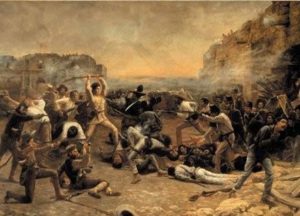1. Why was William Travis’s letter so significant? Just what did it say?
William Travis, the commander at the Texian garrison defending the Alamo, wrote the letter to call for reinforcements to support the garrison and warned what would happen if such reinforcements did not arrive. The letter became a source of inspiration to the Texians who fought for and won Texas independence at the Battle of San Jacinto, and set in motion the events that would lead Texas to join the United States in 1845.
The letter is on display at the Texas State Archives in Austin.
This is what Travis wrote, on February 24, 1836:
To the people of Texas and all Americans in the world—
Fellow citizens and compatriots— I am besieged, by a thousand or more of the Mexicans under Santa Anna— I have sustained a continual bombardment & cannonade for 24 hours and have not lost a man— The enemy has demanded a surrender at discretion, otherwise, the garrison is to be put to the sword, if the fort is taken— I have answered the demand with a cannon shot, & our flag still waves proudly from the walls— I shall never surrender or retreat. Then, I call on you in the name of liberty of patriotism and everything dear to the American character, to come to our aid, with all dispatch— The enemy is receiving reinforcements daily & will no doubt increase to three or four thousand in four or five days. If this call is neglected, I am determined to sustain myself as long as possible and to die like a soldier who never forgets what is due to his honor & that of his country—
Victory or Death
William Barrett Travis Lt. Col. Comdt.
P.S. The Lord is on our side— When the enemy appeared in sight we had not 3 bushels of corn— We have since found in deserted houses 80 or 90 bushels and got into the walls 20 or 30 heads of Beeves.
Travis
2. What is a Bowie knife?
The Bowie knife, made popular by the Alamo defender James Bowie, is named in his honor but was in fact designed by his brother, Rezin Bowie.
Rezin Bowie created the knife to be a hunting knife, but it gained notoriety after being used in a fight, the Sandlot Fight, in 1827. Its blade length ranged between 5 and 24 inches.
According to the historian William R. Williamson, Bowie knives became less popular after the Civil War, particularly with the rise in popularity in Colt revolvers.
3. Are there any pictures that illustrate the battle?
Paintings illustrated the Battle of the Alamo in the days before moving pictures. One of the most famous is the Dawn at the Alamo (1903) by Robert Jenkins Onderdonk (1852-1917). The painting shows Davy Crockett using his rifle as a club during the final siege with the Alamo chapel in the background. Today the painting is in the Texas Governor’s Mansion.
Another famous image (below) is Dawn at the Alamo (1905) by H.A. McArdle (1836-1908). The painting shows the final siege of the battle, which occurred in the early morning of March 6, 1836. To create the painting, McArdle conducted extensive research and interviewed several participants in and witnesses to the battle, including a correspondence with the Mexican president, Antonio Lopez de Santa Anna.
In 1929, the Texas Legislature purchased both Dawn at the Alamo and another McArdle painting, The Battle of San Jacinto (1898). Today these paintings are on display in the Senate chamber of the Texas State Capitol in Austin.
4. The Alamo flag is red, white, and green, and says “1824.” What’s that about? Why not fly the Lone Star Flag of Texas?
Looking at McArdle’s Dawn at the Alamo painting, one can see a red, white, and green flag that says “1824” in the middle. The “1824” refers to the First Mexican Republic, established in 1824, and the government before Santa Anna came to power.
It may well have been the flag that the Texians flew during the battle, but historians have debated whether other flags were used at the battle. For example, C.M. Yates of the Texian Heritage Society writes that the Alamo defenders were interested in Texas independence, and not returning to the way things were under the First Mexican Republic.
Unbeknownst to the Alamo defenders, Texas declared its independence from Mexico on March 2, 1836 at Washington-on-the-Brazos. The final siege of the Alamo occurred on March 6.
The Lone Star Flag of Texas that we know today was adopted in 1839.


